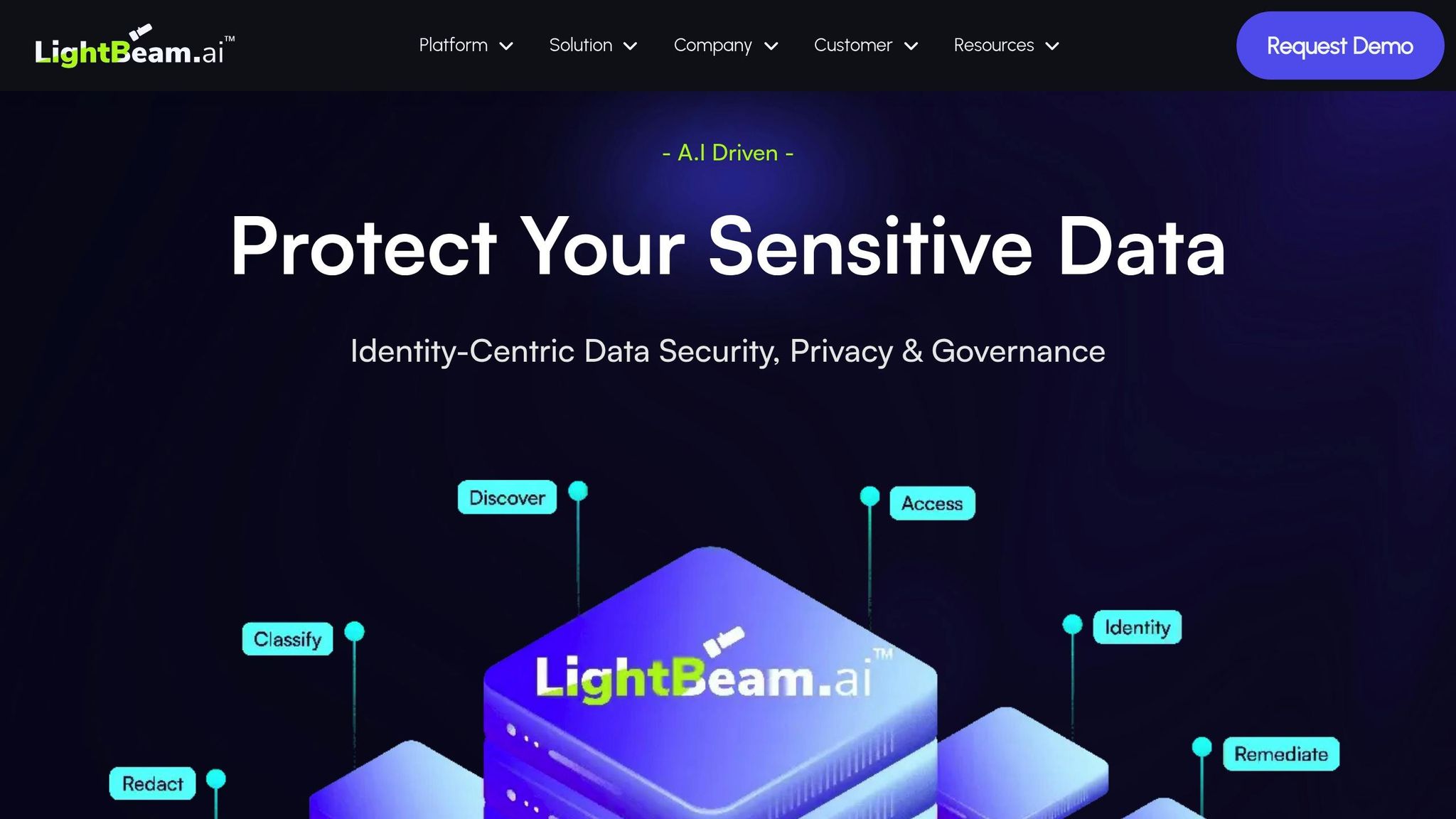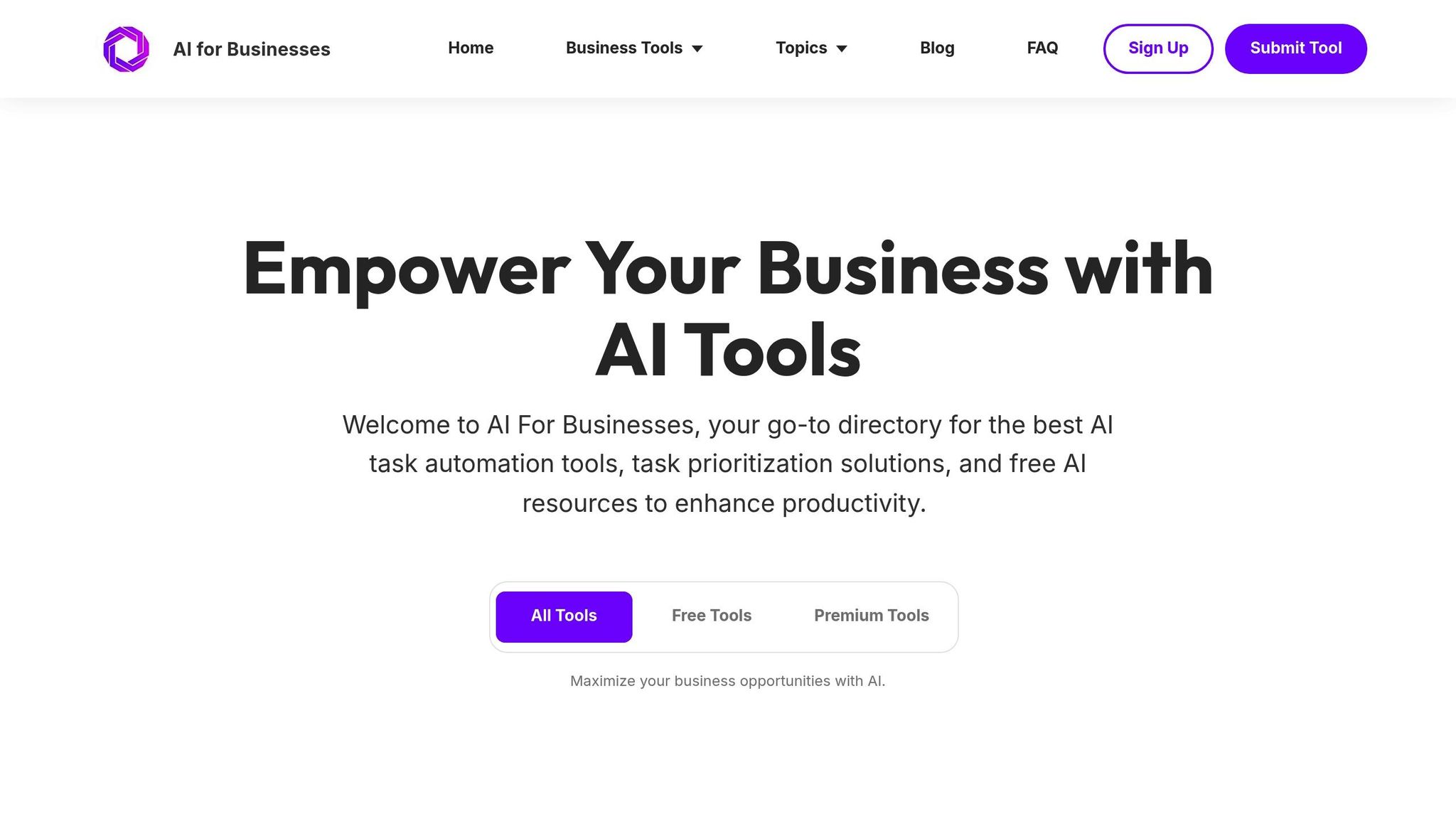Handling GDPR data requests manually can be time-consuming and costly. Automation simplifies this process, ensuring compliance, improving efficiency, and reducing errors. Here's what you need to know:
-
What are GDPR Data Subject Requests (DSRs)?
These are requests from individuals to access, delete, correct, or transfer their personal data. Businesses must respond within 30 days to avoid fines, which can reach up to €20 million or 4% of global revenue. -
Why automate GDPR requests?
Manual handling is expensive and error-prone. Automation cuts costs, improves accuracy, and ensures deadlines are met. It also builds trust by demonstrating a commitment to data privacy. -
Key steps to set up automation:
- Review your current data processes and map all personal data.
- Choose the right automation platform with features like GDPR templates, workflows, and audit tools.
- Configure and test your system, including secure data handling and identity verification.
-
Top tools for automation:
Platforms like OneTrust, Drata, and TrustArc offer features for GDPR compliance, from data mapping to automated workflows. Pricing varies, with options for businesses of all sizes. -
Long-term compliance tips:
Regular system updates, audits, and employee training are essential. Document processes thoroughly and monitor performance to stay ahead of regulatory changes.
Automating GDPR requests not only ensures compliance but also saves time and resources, allowing businesses to focus on growth.
How to Automate Data Subject Requests (DSRs) with LightBeam | DSAR Compliance Made Easy

Planning Your GDPR Automation Setup
To make the most of automation, it’s crucial to start with a solid plan. By understanding compliance requirements, local regulations, and secure processes, you can set up a system that meets GDPR standards while avoiding costly legal issues. A well-thought-out plan ties compliance mandates directly to the practical setup of your automation tools.
GDPR Compliance Requirements You Must Meet
Your plan needs to cover all the key compliance requirements. Start with identity verification - you can’t just hand over personal data to anyone who asks. Have a process in place to confirm the requester's identity before releasing any information.
Your automation system should also track submission dates and send reminders well ahead of the 30-day deadline for responding to data subject requests. To ensure secure data delivery, apply encryption and enforce strict access controls.
Document everything: from the moment a request is submitted to the final outcome. This includes timestamps, verification steps, decisions, and responses. An audit trail like this not only proves compliance but also highlights areas for improvement.
If you need to deny a request due to legal or operational reasons, provide a clear explanation. Your automation system can include response templates for different scenarios, but make sure communications still feel personal and human.
US Business Considerations for GDPR Automation
For U.S. businesses, GDPR compliance often overlaps with state privacy laws. By 2025, twenty U.S. states will have comprehensive data privacy laws. If your company serves EU/EEA citizens or monitors their behavior, GDPR applies to you - even if you’re based in the U.S.. This includes U.S. citizens who are temporarily in EU/EEA countries. Even a website that attracts European visitors can trigger GDPR obligations.
Fines for non-compliance are steep. Standard violations can cost up to $12 million or 2% of annual revenue, while intentional breaches can reach $24 million or 4% of yearly income. These penalties make a strong case for investing in a reliable automation system.
Operationally, you may need to appoint a Data Protection Officer (DPO) if you lack assets in the EU/EEA. Other requirements include conducting privacy audits, establishing legal grounds for data processing, drafting compliant privacy policies, and creating Data Processing Agreements (DPAs) with third parties.
Interestingly, building a GDPR-compliant system often helps meet other privacy law requirements as well. While GDPR has broader reach than regulations like CCPA, many of the processes - such as data mapping and access controls - overlap.
Setting Up Secure and Transparent Processes
Once you’ve nailed down the compliance requirements, focus on secure and transparent processes. Assign a Data Protection Officer (DPO) and designate data stewards to clarify roles and responsibilities.
Conduct audits to classify and map all data within your organization. A detailed map of data flows is essential for identifying potential compliance gaps - it’s impossible to automate what you don’t fully understand.
Implement tools like role-based access controls (RBAC) and multi-factor authentication to restrict access to sensitive data. Your automation system should work seamlessly with these security measures, not sidestep them.
Automate data retention and deletion to manage storage efficiently and maintain compliance. Link your Record of Processing Activity (ROPA) to actual data so you can respond proactively to changes.
Use monitoring tools to track data access, modifications, and potential breaches. Regular audits can help you catch and fix issues before they escalate into compliance violations. Make sure your system integrates with breach detection tools and supports the 72-hour reporting requirement under GDPR.
Finally, training is key. Even the best automation tools won’t help if your team doesn’t know how to use them. Ongoing education ensures your staff stays up to date as regulations and systems evolve.
How to Set Up GDPR Request Automation
Now that you've mapped out your strategy, it's time to create your automated system. This process involves three key steps: understanding your current data setup, selecting the best platform, and configuring the system to function efficiently. Each step builds on the last, so take your time to ensure everything is well-structured. This setup directly connects to your earlier compliance planning and data mapping efforts.
Step 1: Review Current Processes and Data Sources
Start by revisiting your compliance plan and taking a close look at your data landscape. Create an inventory of all systems that store personal information. Identify sensitive data, track how it flows through your systems - including any third-party integrations - and map out how it’s processed and deleted.
"It is quite difficult, for example, to prepare a privacy statement or an internal privacy policy without understanding what data is collected, how it is processed, and with whom it is shared."
Once you've mapped everything, assess the associated risks. This will help you identify compliance gaps and potential vulnerabilities, offering a clearer picture of where automation can make the biggest impact in meeting GDPR requirements.
Step 2: Choose and Set Up an Automation Platform
With your data inventory complete, the next step is selecting the right automation platform. Look for one that offers pre-built compliance frameworks, which can reduce setup time significantly - by as much as 50%. The best platforms include features like GDPR templates, automated workflows, audit evidence collection, vendor monitoring, continuous compliance checks, API integrations, and access to experts.
Involve key stakeholders from different teams early on, and choose a platform that can grow with your privacy needs. Here’s a comparison of top GDPR automation tools to help guide your decision:
| Platform | Key Strengths | Best For | Pricing Model |
|---|---|---|---|
| Scrut Automation | 70+ integrations, daily security checks, real-time dashboard, 24×5 support | Scaling companies up to 5,000 users | Custom pricing (all modules included) |
| Drata | Fast setup, strong evidence automation, instant compliance dashboard | Organizations needing quick implementation | Contact for pricing |
| Sprinto | Multi-entity compliance, unified view, strong privacy controls | Companies with multiple business entities | Contact for pricing |
| OneTrust | Comprehensive data mapping, visual data flows, free version available | Large enterprises with complex data setups | Free version available; premium tiers |
While automation simplifies many processes, remember that initial setup can take time, especially if your organization has complex systems or extensive data flows.
Step 3: Configure and Test Your Automation System
Set up automated intake forms to collect key details for GDPR requests such as access, rectification, erasure, portability, and objection. Make sure to include identity verification as part of the process. Create response templates that automatically route requests based on factors like data type, the requester’s relationship to your organization, and any applicable legal exceptions. For cases requiring extra attention, develop workflows for manual review.
Testing is crucial. Simulate different types of requests, verify that retention policies and data deletion processes work as intended, and run mock breach scenarios to ensure you're ready to handle notifications. Incorporate penetration testing and vulnerability assessments into your testing routine. Regular testing cycles, especially after updates or changes to your systems, are essential for staying compliant and avoiding costly issues.
sbb-itb-bec6a7e
Top Tools for GDPR Request Automation
Once your system is set up, the next step in your compliance strategy is choosing the right tools. With a solid foundation in place, it’s time to explore some of the top options for managing GDPR requests effectively.
Leading GDPR Automation Tools
For US businesses handling EU data, certain GDPR automation tools stand out for their efficiency and reliability. OneTrust Privacy Management is a popular choice, offering detailed data mapping and visualization capabilities. With strong user ratings on G2 (4.3/5) and Gartner (4.2/5), it’s particularly suitable for organizations with intricate data architectures.
If your business focuses on both security and compliance, the Varonis Data Security Platform is a robust option. It combines GDPR request automation with advanced security features, including breach detection, making it a dual-purpose tool. It’s highly rated, scoring 4.5/5 on G2 and 4.8/5 on Gartner.
Another reliable solution is TrustArc, which is well-suited for businesses navigating multiple privacy regulations, such as the GDPR and the California Consumer Privacy Act (CCPA). It holds a consistent 4.2/5 rating on both G2 and Gartner, making it a dependable choice for companies managing diverse compliance needs.
For businesses seeking cost-effective solutions, there are several affordable options:
- Ketch: $150 per month (annual plan)
- Ethyca: $75 per month
- Termly: $10 per website per month
- Clym: $49 per month
The stakes for non-compliance are high. For instance, Twitter faced a €450,000 ($546,000) fine in December 2020 for failing to notify GDPR regulators of a data breach within the required 72-hour window.
When evaluating tools, focus on their ability to handle key functions like data management, consent tracking, and automated breach notifications. Additionally, ensure the software integrates smoothly with your existing systems, such as CRM, ERP, and marketing platforms.
A PwC survey revealed that US companies spend anywhere from $1 million to over $10 million annually to maintain GDPR compliance. Given these significant costs, investing in the right tools can streamline processes and save resources in the long run.
Find More Tools Through AI for Businesses

Beyond traditional tools, AI-powered solutions are transforming GDPR compliance. AI for Businesses is an extensive directory designed to help small and medium-sized enterprises discover AI tools tailored to enhance operational efficiency, including advanced GDPR compliance solutions.
This platform offers tools that leverage artificial intelligence for tasks like data discovery, consent management, handling data requests, breach detection, and ongoing compliance monitoring. As GDPR requirements grow more complex, these AI-driven capabilities can provide a much-needed edge.
AI for Businesses provides flexible access plans:
- Basic Plan: Free access to a limited selection of AI tools, ideal for initial testing.
- Pro Plan: $29 per month for unlimited access and priority support.
- Enterprise Plan: Custom pricing with dedicated support and bespoke tool integration.
This curated approach is particularly useful for US companies of all sizes handling EU data. Whether you're a sole proprietor managing occasional EU customer interactions or a larger business with complex international operations, these tools can help you develop a well-rounded compliance strategy.
Maintaining GDPR Compliance Long-Term
Setting up automated GDPR systems is just the first step. Long-term compliance requires consistent effort, regular updates, and continuous monitoring to ensure your systems stay effective as regulations change and your business evolves. By committing to these practices, you can maintain GDPR compliance over time without unnecessary disruptions.
Regular System Updates and Compliance Audits
Even after automation is in place, routine updates and monitoring are crucial. Review your automated workflows every quarter to ensure they align with current regulations. Adjust automation rules as needed to account for changes in data collection practices or system integrations.
Annual Data Protection Impact Assessments (DPIAs) are a must. These assessments help identify privacy risks and confirm that your technical safeguards are still effective. Regular GDPR audits can also significantly reduce the risk of non-compliance - by as much as 50% according to research. This makes the time and resources spent on audits a worthwhile investment.
Monitor your system performance monthly, keeping an eye on response times, data accuracy, and any system failures. Set up alerts to flag delays, especially for the 30-day GDPR response deadline, so you can address issues promptly.
Employee Training and Process Documentation
Automation is only as reliable as the people managing it, which makes training and clear documentation key components of GDPR compliance. Employees play a critical role, even in highly automated systems, so providing ongoing, role-specific GDPR training is essential.
Host annual training sessions tailored to the specific needs of each department. Complement these sessions with well-documented manuals that explain your automated processes, including system functionality, oversight requirements, and how to handle exceptions. Keeping detailed records of training activities not only ensures preparedness but also demonstrates compliance during regulatory inspections.
The consequences of inadequate training are serious. For example, in 2020, the UK Information Commissioner’s Office (ICO) fined the Cabinet Office £500,000 (about $680,000) for publishing the 2020 Honours List with recipients' postal addresses, citing insufficient data protection training as a major factor. To avoid similar issues, update your training materials annually or whenever regulations change, and include practical scenarios that are directly relevant to your automated systems.
"Training and awareness on data protection issues of the staff of the controller is essential for the controllers. This training should be regularly repeated, depending on the type of processing activity and size of the controller, addressing the latest trends and alerts coming from cyberattacks or other security incidents." (EDPB Guidelines on Data Breach Notification Examples)
Common Mistakes to Avoid
Understanding and avoiding common mistakes can save your business from costly fines and reputational damage. Here are some best practices to keep in mind:
| Best Practice | Common Mistake | How to Avoid |
|---|---|---|
| Ongoing training | Assuming automation eliminates training needs | Offer annual, role-specific GDPR training for all staff handling personal data. |
| Comprehensive data mapping | Overlooking some automated data sources | Map all data sources quarterly and update automation rules for new systems. |
| Transparent consent mechanisms | Using pre-checked boxes or vague consent terms | Use clear opt-in options with plain, easy-to-understand language. |
| Robust breach response | Delaying breach reporting beyond 72 hours | Set up automated breach detection and notification with clear escalation plans. |
| Regular system audits | Neglecting automation after setup | Schedule quarterly reviews and annual compliance audits. |
| Proper vendor oversight | Ignoring third-party compliance | Conduct thorough vendor assessments and regular compliance checks. |
The financial risks of non-compliance are steep. GDPR violations can result in fines of up to 4% of global turnover or €20 million (about $21.6 million). Additionally, the average cost of a data breach is $4.24 million. Compared to these potential penalties, investing in ongoing compliance efforts is a far more cost-effective strategy.
Conclusion
Automating GDPR data subject requests turns labor-intensive tasks into streamlined, scalable operations that benefit both your organization and its customers. For instance, OneTrust reports that automating DSRs can slash fulfillment costs by up to 99%, while Ketch highlights a 90% reduction in setup time for adapting to new regulations and data rights. These savings free up your team to focus on strategic priorities rather than repetitive administrative tasks.
A well-designed GDPR automation system builds upon your existing processes, reducing both the workload and the risks tied to non-compliance. As a Senior Manager of Privacy and Data Compliance at a consumer goods company shared:
"The automation of processes like DSARs, risk assessments, and data mapping and cataloging allows my privacy team of four people to do the work of nine people."
Beyond avoiding fines, automation fosters trust by ensuring privacy rights are handled efficiently and transparently.
To make the most of GDPR automation, your system should integrate smoothly into current workflows, include secure customer portals, and maintain comprehensive audit trails. By customizing intake methods and using automated workflows aligned with your data mapping and auditing practices, you can significantly streamline the fulfillment process.
Companies that excel in GDPR automation often see it as more than compliance - it’s a way to build stronger customer relationships while protecting their bottom line. When integrated into a broader compliance strategy, such systems not only safeguard personal data but also reinforce overall business resilience. With the right tools, approach, and ongoing maintenance, GDPR automation can become a key competitive edge in today’s privacy-focused world.
FAQs
What challenges do businesses face when automating GDPR data requests, and how can they address them?
Automating GDPR data requests can be tricky because of the extensive scope of GDPR regulations, including its reach beyond borders, and the pressure to handle requests promptly and accurately. Many businesses find it hard to manage massive amounts of data while staying aligned with principles like transparency, limiting data use, and prioritizing privacy from the start.
One way to tackle these hurdles is by using automation tools. These tools simplify the process, cut down on manual work, and help ensure precision. They allow businesses to efficiently track, verify, and respond to data subject requests while staying within GDPR guidelines. On top of that, creating clear internal workflows and training employees on GDPR best practices can boost compliance and make operations run smoother.
How can automating GDPR data requests improve a business's compliance and security?
Automating GDPR data requests offers businesses a practical way to strengthen compliance and bolster security. By reducing reliance on manual processes, automation minimizes the chance of human error, ensures requests are addressed on time, and keeps a clear, organized record of all data-related activities. This not only helps meet deadlines but also lowers the risk of incomplete responses that could lead to costly non-compliance fines.
Beyond compliance, automation makes audits far more straightforward and improves how data is managed overall. With automated tools in place, companies can shift their focus toward actively managing privacy concerns while staying aligned with GDPR standards.
What are the risks of using only automation for GDPR compliance, and how can businesses address them?
Relying solely on automation for GDPR compliance can be risky. Issues like misconfigurations, software glitches, or cybersecurity gaps might lead to data breaches or non-compliance. While automation tools are efficient, they often struggle with handling complex or unique situations, which increases the chance of mistakes.
To minimize these risks, businesses should pair automation with manual oversight through regular audits and quality checks. Strengthening cybersecurity measures is also crucial to safeguard automated systems and ensure compliance processes stay secure and dependable.


